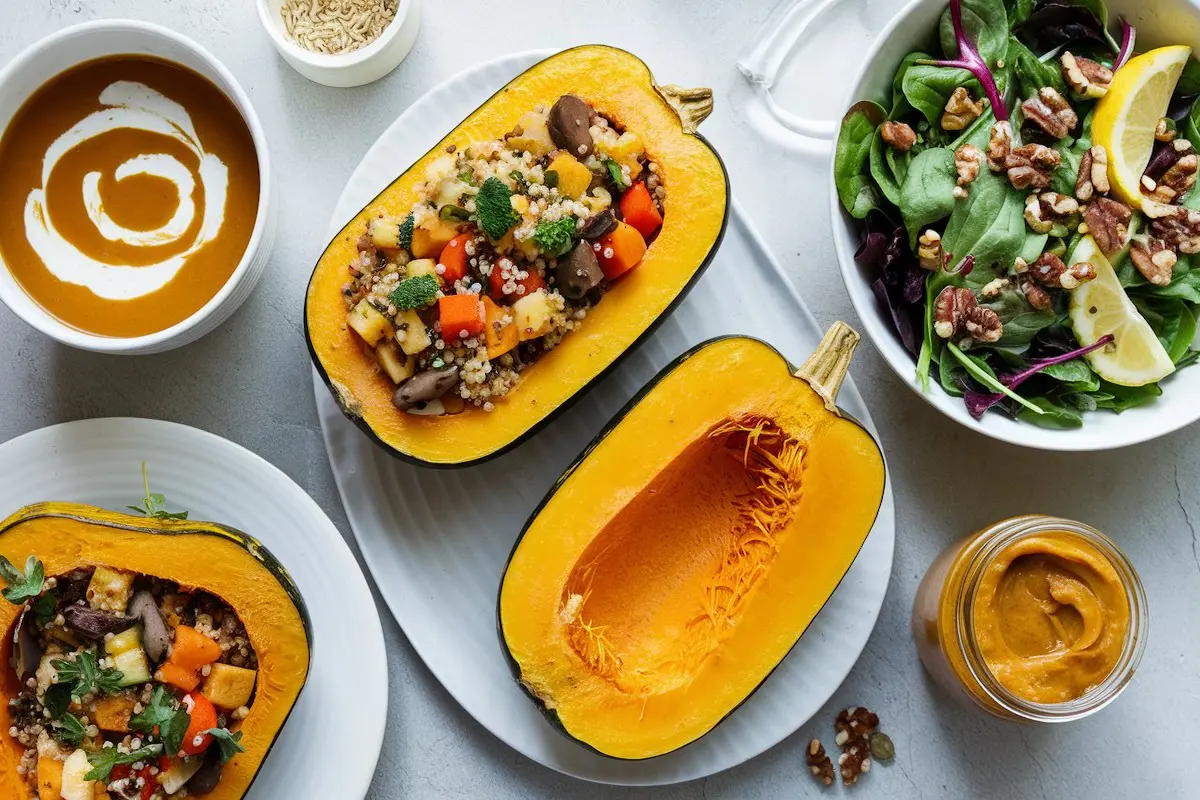Kabocha squash, commonly known as Japanese pumpkin, is not only a culinary star but also a nutritional powerhouse. As you explore this guide, you’ll discover why it is such a valuable ingredient in vegan cooking. Its naturally sweet flavor, creamy texture, and versatility make it a staple in many kitchens. Moreover, its low-calorie and nutrient-dense nature ensures that it fits into a wide variety of diets. Whether you’re a seasoned chef or someone new to plant-based recipes, kabocha squash has something unique to offer.
What Is Kabocha Squash?
To begin with, kabocha squash is a type of winter squash known for its tough, dark green skin and vibrant orange flesh. Additionally, its rich flavor and velvety texture make it ideal for an array of dishes. Notably, it is a favorite in Japanese cuisine, but it has also gained popularity worldwide.
Furthermore, kabocha squash is not just delicious; it’s highly nutritious. Packed with vitamins A and C, antioxidants, and fiber, it supports overall health while being incredibly satisfying. Unlike some other squashes, kabocha is naturally low in calories, which makes it an excellent choice for health-conscious eaters.
Selecting and Preparing Kabocha Squash
How to Choose the Best Kabocha Squash
First and foremost, selecting the right kabocha squash is crucial for any recipe. To make the best choice:
- Look for squash that feels heavy for its size, as this indicates freshness and high moisture content.
- Check the skin—it should be firm, dull, and free of blemishes. While shiny skin often suggests immaturity, a matte finish means the squash is ripe.
- Inspect the stem; a dry and corky texture indicates optimal ripeness.
How to Prepare Kabocha Squash
Once you’ve chosen your squash, it’s time to prepare it. However, its hard skin can make preparation challenging. Follow these steps to ensure safety and efficiency:
- Wash the squash thoroughly to remove any dirt or residue.
- Using a sharp knife, carefully slice it in half. To make cutting easier, consider microwaving the squash for 2-3 minutes to soften the skin slightly.
- Scoop out the seeds and fibrous strands. If you wish, save the seeds for roasting later.
- Decide whether or not to peel the skin. While it softens during cooking and is entirely edible, some recipes may call for a smoother texture.
Why Kabocha Squash Is Perfect for Vegan Recipes
There are many reasons why kabocha squash stands out in vegan cuisine. First, its creamy consistency eliminates the need for dairy in soups, sauces, and purees. Additionally, its naturally sweet flavor reduces the need for added sugars in desserts. As a result, it’s both a flavorful and health-conscious choice.
Moreover, kabocha squash pairs exceptionally well with other plant-based ingredients. Whether you’re combining it with coconut milk, ginger, or cinnamon, it enhances the overall taste profile. It’s also a fantastic way to add nutrients and variety to your meals.
To learn more about versatile vegan ingredients, don’t miss the Ultimate Guide to Vegan Ingredients.
Vegan Kabocha Squash Recipes
1. Creamy Kabocha Squash Soup

This soup is not only warm and comforting but also rich in flavor, making it perfect for chilly evenings.
Ingredients:
- 1 medium kabocha squash
- 1 tablespoon olive oil
- 1 onion, diced
- 2 garlic cloves, minced
- 1 teaspoon grated ginger
- 4 cups vegetable broth
- 1 can coconut milk
- Salt and pepper to taste
Instructions:
- Begin by roasting the squash at 400°F until tender, about 40 minutes.
- Meanwhile, sauté onion, garlic, and ginger in olive oil until fragrant.
- Add the roasted squash, vegetable broth, and coconut milk to the pot. Then, simmer for 10 minutes.
- Blend the mixture until smooth, season with salt and pepper, and serve warm.
2. Vegan Thai Kabocha Curry
Next, try this vibrant curry that balances the sweetness of kabocha with the heat of red curry paste.
Ingredients:
- 1 medium kabocha squash, cubed
- 1 tablespoon coconut oil
- 1 onion, sliced
- 2 tablespoons red curry paste
- 1 can coconut milk
- 1 cup vegetable broth
- Juice of 1 lime
- Fresh basil or cilantro for garnish
Instructions:
- Heat coconut oil in a large pot and sauté the onion until soft.
- Stir in the red curry paste and cook for 2 minutes to release its flavors.
- Add the squash, coconut milk, and vegetable broth. Simmer until tender.
- Finally, stir in lime juice and garnish with fresh herbs.
To explore more creative ways to use squash in curries, check out this Vegan Thai Kabocha Squash Curry Recipe.
Tips for Cooking with Kabocha Squash
To ensure the best results, consider these tips when working with kabocha squash:
- Maximize its flavor: Roasting enhances its natural sweetness, while steaming retains more of its nutrients.
- Use the skin: Since the skin becomes tender when cooked, leaving it on can save time and add fiber to your dish.
- Store wisely: Whole squash can last up to a month in a cool, dry place. Cut pieces, however, should be refrigerated and used within five days.
Health Benefits of Kabocha Squash
In addition to its culinary versatility, kabocha squash offers numerous health benefits:
- Rich in nutrients: High levels of vitamins A and C support vision, skin health, and immunity.
- Fiber-packed: Its fiber content promotes digestion, stabilizes blood sugar, and helps with weight management.
- Low calorie: Despite its creamy texture, kabocha is low in calories, making it a guilt-free choice.
By incorporating it into your diet, you can enjoy a delicious ingredient that also contributes to a healthier lifestyle.
Frequently Asked Questions (FAQs)
Is the skin of kabocha squash edible?
Yes, once cooked, the skin becomes tender and is entirely edible.
Can kabocha squash be used in desserts?
Absolutely! Its natural sweetness makes it an excellent choice for pies, puddings, and even cheesecakes.
What’s the best way to store kabocha squash?
Whole squash should be kept in a cool, dry place for up to a month. Once cut, store it in an airtight container in the refrigerator.
Conclusion: Unlock the Potential of Kabocha Squash
In conclusion, kabocha squash is a versatile and nutrient-rich ingredient that deserves a place in every vegan kitchen. Its sweet flavor, creamy texture, and adaptability make it suitable for a wide range of recipes, from savory soups to indulgent desserts.
Whether you’re just starting your journey with plant-based cooking or looking for new ideas, these recipes will inspire you to embrace kabocha squash. For more ideas, visit crisp fresh recipes. With its endless possibilities, kabocha squash is sure to become a favorite in your culinary repertoire!

